In mid-October of 1975 (with Stan Haye) and again in mid-October of 1981 (with Jimmy White) I visited the Beveridge Canyon millsite. This millsite served the Keynot Mine and is accessible only by trail or helicopter.
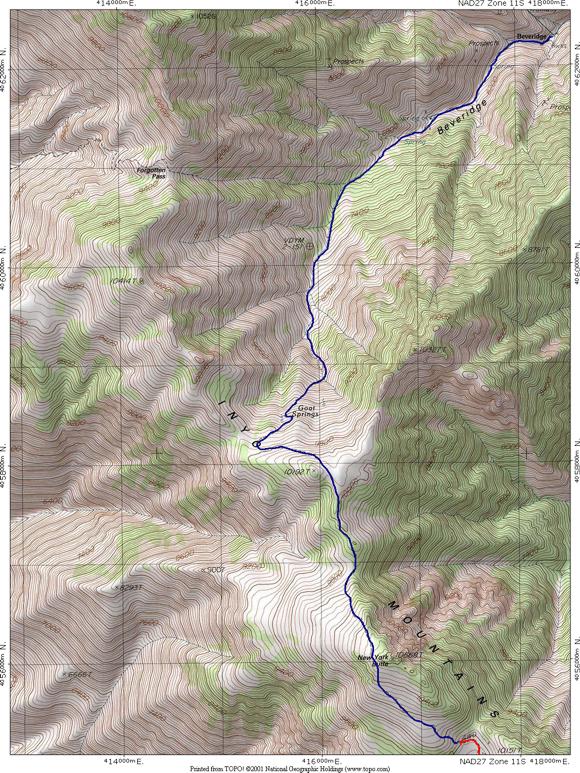
Trail Map to Beveridge
In her book Mines of the Eastern Sierra, La Siesta Press, 1966 Mary DeDecker writes:
"Beveridge, which was the most important gold producing district in Inyo County, has remained the most inaccessible. It's mines and mills tucked into a maze of canyons on the precipitous east face of the Inyo Mountains were reached only by trails. ... Occasional springs were the only source of water, and they were few and far apart. In some instances the flow was enough to create running streams in the canyons before being lost in the thirsty gravel.
Such places were blessed with streamside trees -- willow, cottonwood, or even oak. As a whole, however, wood was extremely scarce, except for a fair amount of pinyon at higher elevations and a fringe of bristlecone and limber pine on the peaks. Most of the important requirements for mine production were scare or missing, but the gold was there, so hardy miners appeared on the scene and proceeded to overcome the obstacles."
She provides further information about the history of the district and it's several groups of mines. About Beveridge Canyon she writes:
"The Keynot group, of seven claims on the ridge north of Keynot Canyon, made the record for the greatest production in the district. It also had the most extensive development, including seven tunnels from 150 to 750 feet long. It's deepest mine went down 1800 feet. Ore was carried three miles by pack mules to a five-stamp mill in Beveridge Canyon, formerly Hahn's Canyon." [In later years a tramway was built].
"This amazing accomplishment of transporting heavy mill machinery so far by trail paid off in savings of costs for carrying ore. Beveridge Camp, below the junction of Cave and Beveridge canyons, was, and still is, by far the most inaccessible of the mining camps of the Inyos. Hence, it has had few visitors since it was abandoned and shortage of water along the route makes the trail a difficult one.
The mine was operated continuously from 1878 to 1886, and then intermittently until 1907. The total production figure is $500,000." [Proposals to re-open the Keynot mine surfaced around 1981 and some money was spent but the project was later abandoned.]
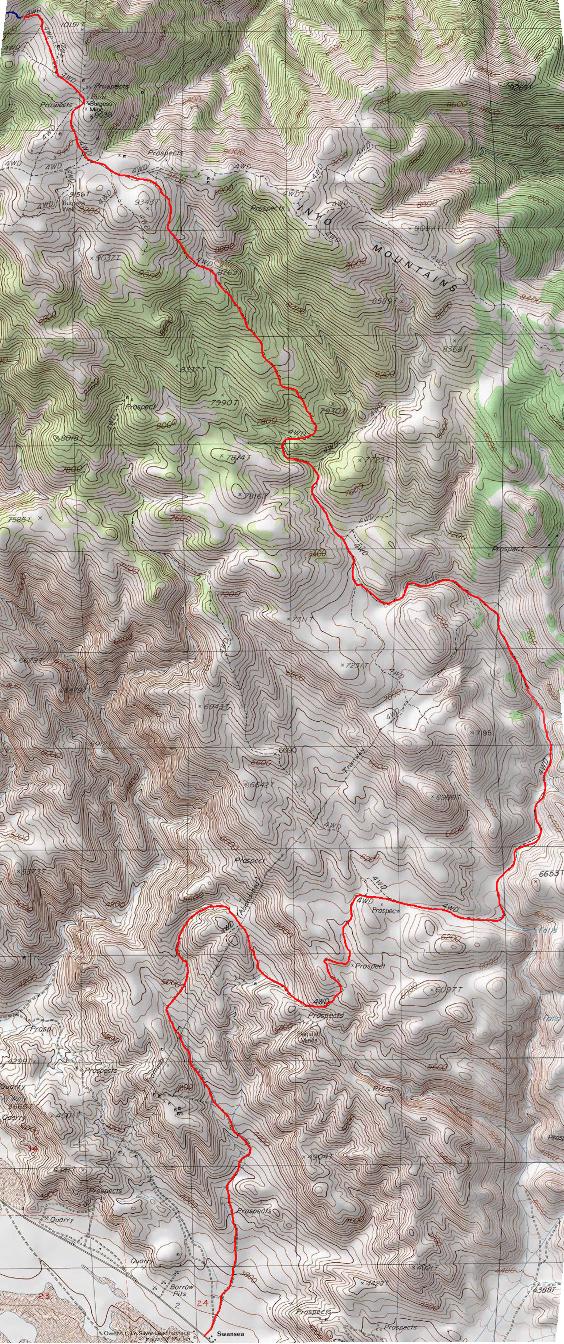
Route map Swansea to trailhead west of Burgess Mine - Beveridge Canyon trip
Although a trail leads from the Owens Valley floor in Long John Canyon to the top of the Inyos, modern day access is available via a road that originates at Swansea on State Route 136 west of Keeler.
Portions of this 14 mile road route requires four-wheel drive. The majority, however, is relatively good dirt road. There is a 6000+ foot elevation gain as the road climbs from Swansea (3649') to the trailhead (9775') west of the Burgess Mine. The trailhead for Beveridge Canyon is slightly over a mile beyond the Burgess Mine.
A salt tram was once operated from the Saline Valley, over the top of the Inyo Mountains to near Swansea. From this road you can see the salt tram remnants as you climb to the top of the Inyos and drive to the Burgess Mine site, also described in Mary DeDecker's book. This road also leads south along the crest of the Inyos to the salt tramway ridge top terminal and beyond.
On October 11-13, 1975 with Stan Haye, and October 10-12, 1981 with Jimmy White I visited the Beveridge Canyon millsite.
We drove the four-wheel drive road to the trailhead west of the Burgess Mine and then hiked north along the Inyos ridge, past New York Butte (which we climbed in 1975) to a saddle near which are several small springs for water, then down into Beveridge Canyon.
The approximately 6.4 mile trail route to the Beveridge Canyon Millsite gains 960 feet and loses 5,197 feet going in. It's an "upside down hike", so remember you have to "climb" out of the canyon to get back. The elevation of Beveridge is 5,565'.
Trails in the Inyo Mountains generally do not deteriorate much over time so most of this trail is in good shape. Near the start, views from New York Butte are worth the short climb to it's top.
On both trips we camped next to a cabin belonging to the Green Bear mine and both times we got snowed on.
A fire hydrant like spring comes gushing out of the ground at this cabin with a walnut tree nearby.
The water disappears back into the gravel down stream, then reappears at the Beveridge millsite.
Remnants of wooden pipe are found along the trail, indicating that at times the miners had to pipe the water from this spring down to the millsite.
It is about a one mile hike down to the millsite from this cabin.
The millsite itself, as you will see in the following pictures, is remarkably well preserved. This is primarily because of its remote location and that access is limited to trail or helicopter.
The Bureau of Land Management has also taken steps to protect this historical site.
Originally ore was transported to the site by pack animal but in later years a tramway was built.
When we visited, most of the cables for the tram were still in the air. Also in later years gasoline engines and other more modern mechanical mechanisms were brought to the site.
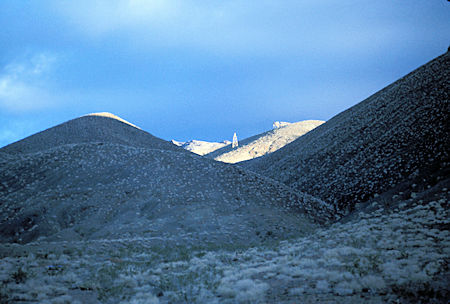
Abandoned salt tramway towers from the road out of Swansea
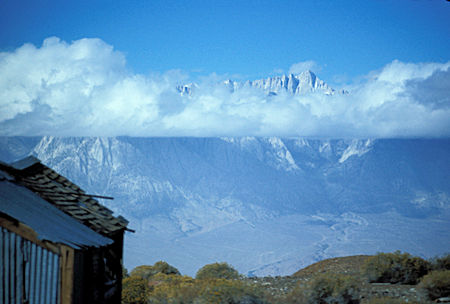
Mt. Whitney in the Sierra Nevada range seen from the Burgess Mine site
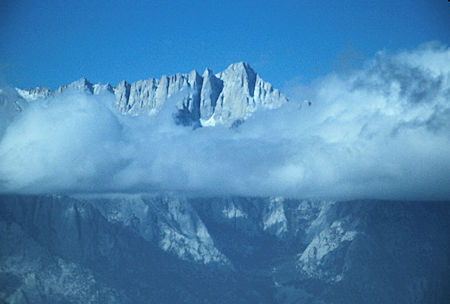
Mt. Whitney from the Burgess Mine site in the Inyo Mountains.
Notice the inversion layer in the clouds
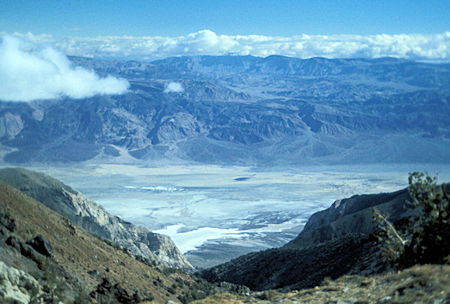
View from the Burgess Mine of the Saline Valley from which the old salt tram ran
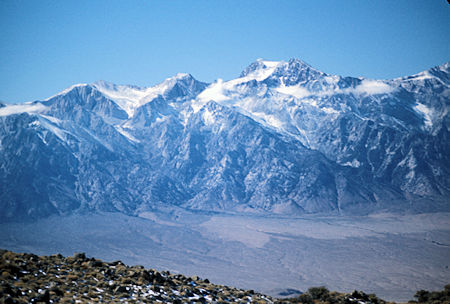
Mt. Williamson in the Sierra Nevada from near New York Butte in the Inyo Mountains
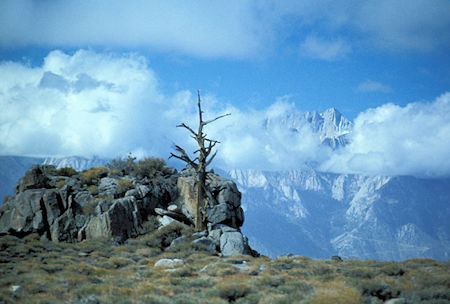
Mt. Whitney from Inyo Mountains on a ridge near New York Butte
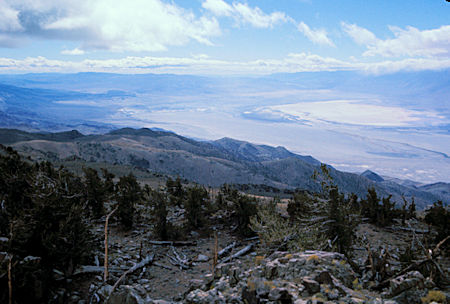
Owens dry lake from New York Butte
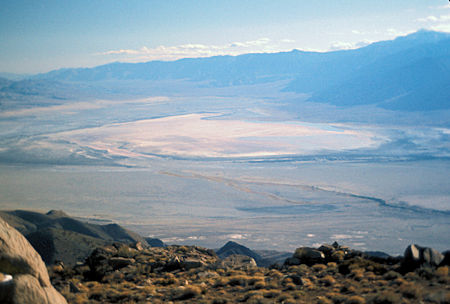
Owens dry lake from near Burgess Mine
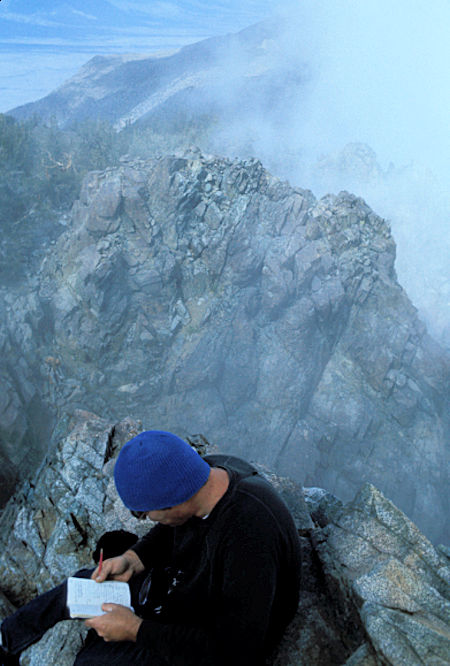
Stan Haye reading register on summit of New York Butte
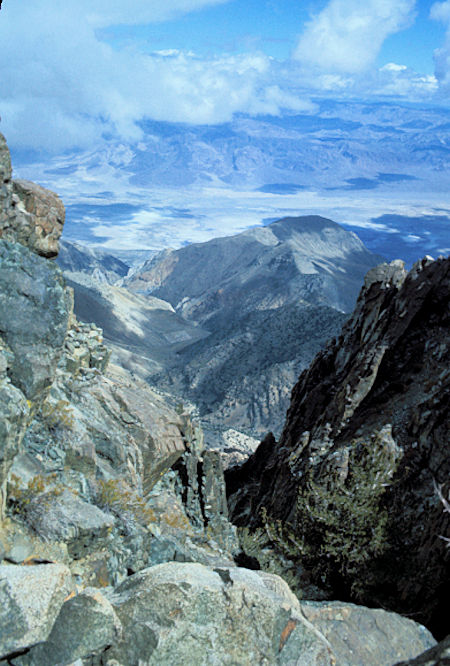
Looking down Hunter Canyon from near New York Butte
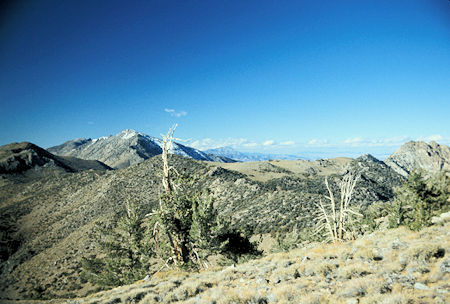
Looking north along Inyo Mountains toward Keynot Peak and saddle leading
to Beveridge Canyon
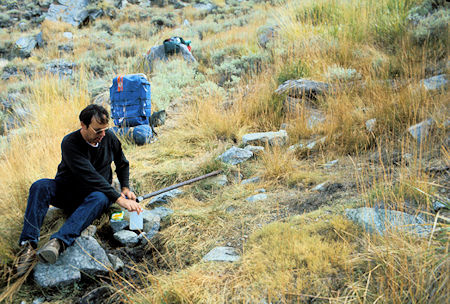
Stan Haye getting water from the small spring just below the saddle before descending
into Beveridge Canyon
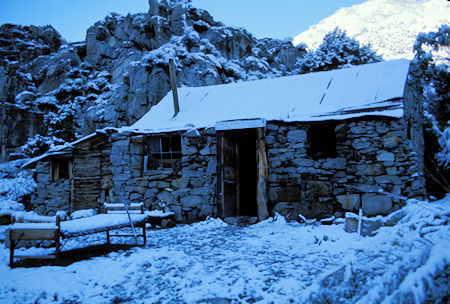
Green Bear Mine cabin where we camped in the snow on both trips
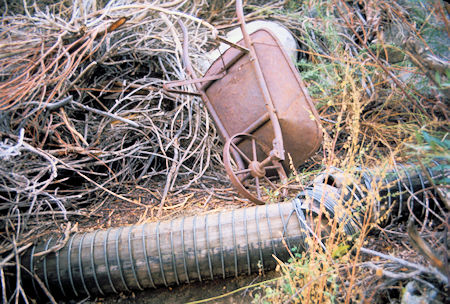
Old wheelbarrow and wooden pipe. The pipe carried water from a giant spring
at the Green Bear Mine cabin down to Beveridge
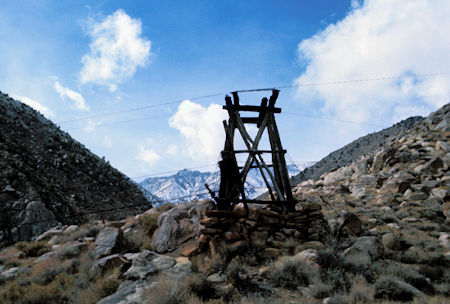
The mine is high on the side of a mountain. The tram down to the mill site
has most towers still standing and the cables are still there
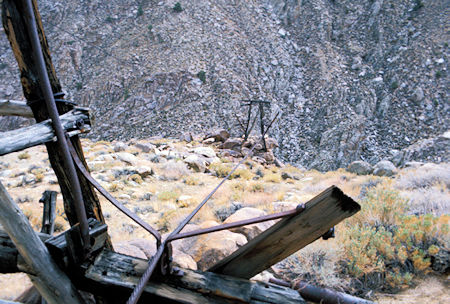
Looking down the tram line toward the mill site. Note that the support for the cable
has fallen from the tower and lays on the ground but still holds the cable
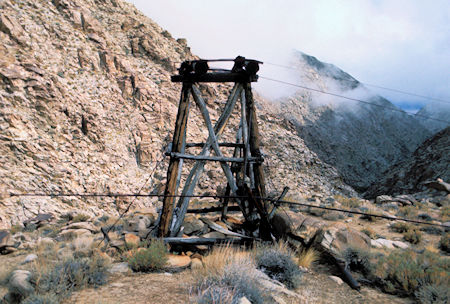
Tram tower below the mine
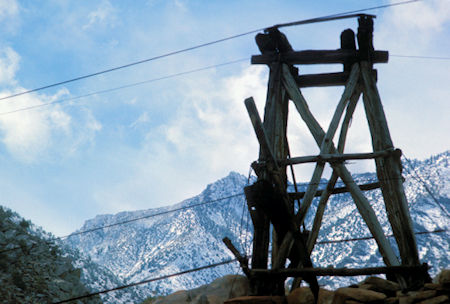
Tram tower below the mine
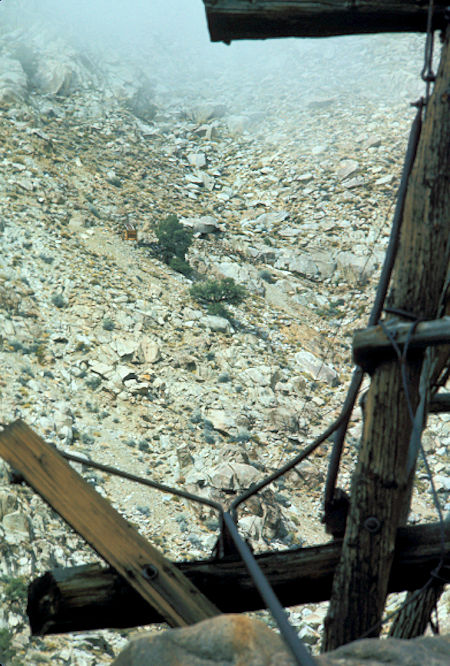
Looking up the tram line toward the Keynot mine which is the brown
just to the left of the upper greenery
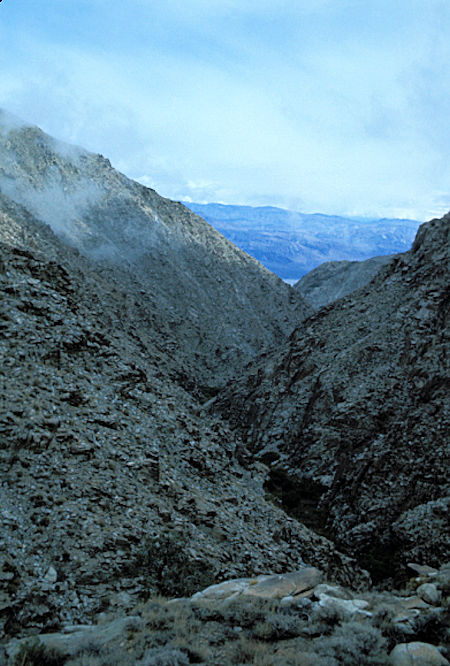
Looking down Beveridge Canyon from near the mine
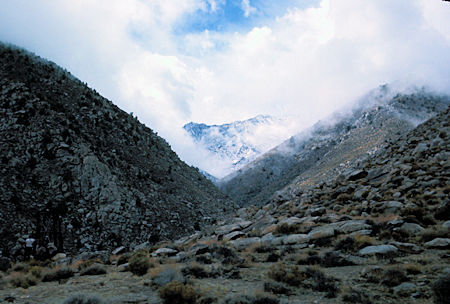
Looking up canyon from near the mine toward the saddle at the head of the canyon
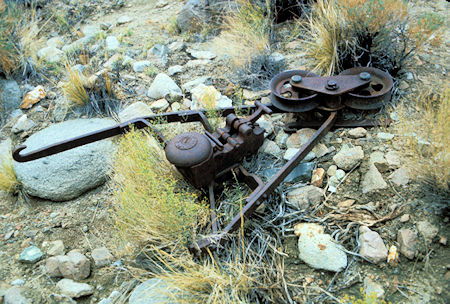
Broken ore bucket hanger
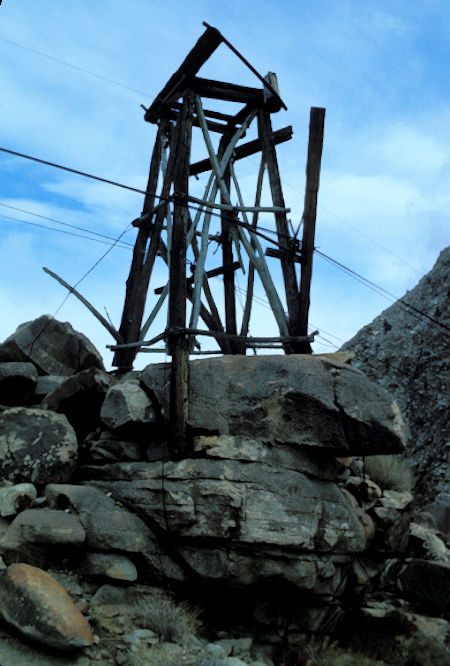
Tram tower
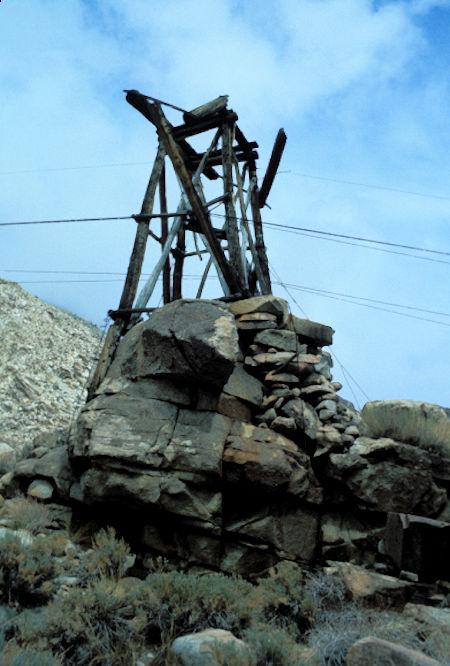
Tram tower
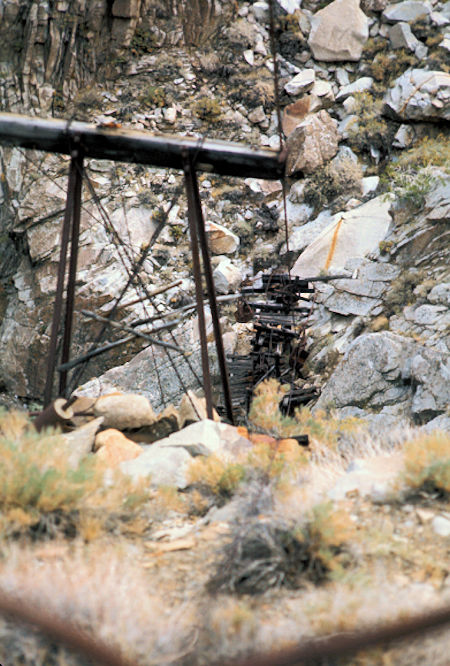
Looking down the tram to its bottom terminal in Beveridge Canyon
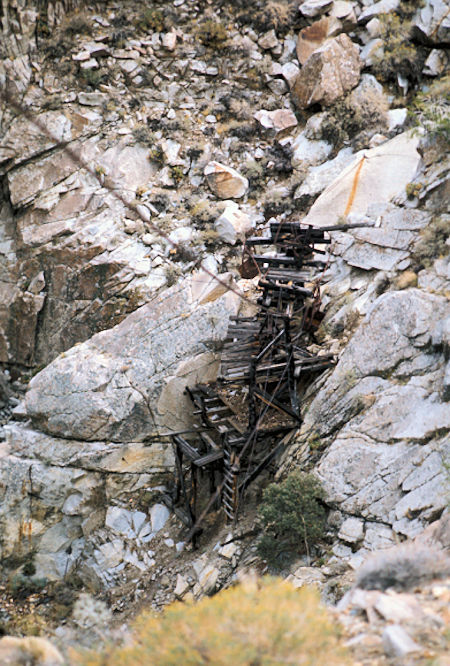
Lower tram terminal. There was a conveyor belt system onto which the ore was dumped
... which has collapsed into the creek
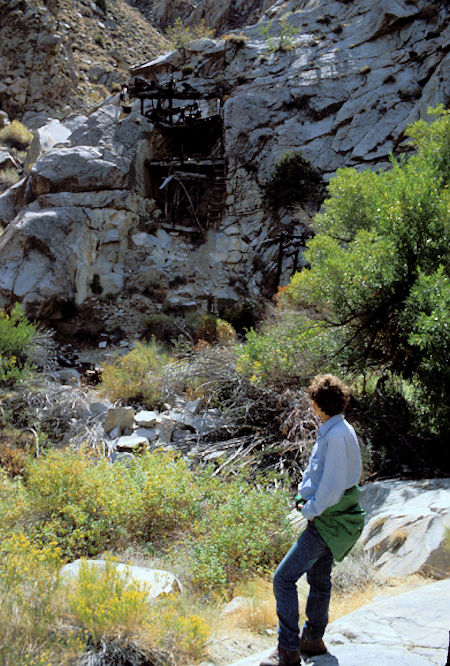
Jimmy White looking across Beveridge Creek at the lower tram terminal in 1981
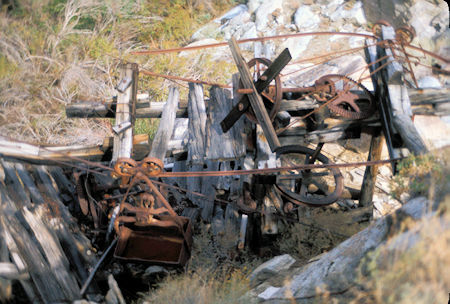
Looking down on the lower tram terminal. Note the ore bucket on the rail
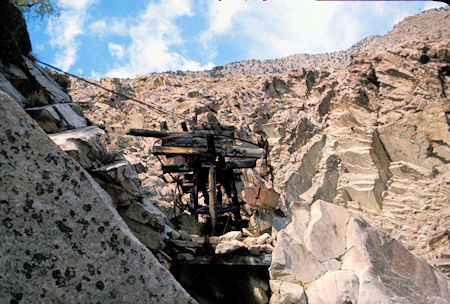
Lower tram terminal ... note ore bucket
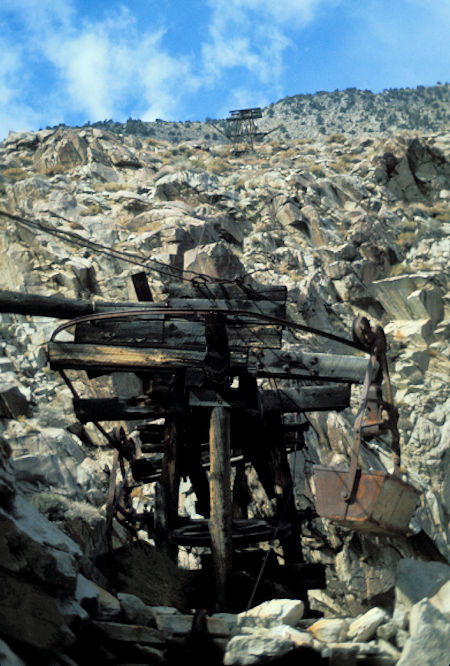
Lower tram terminal ... ore bucket
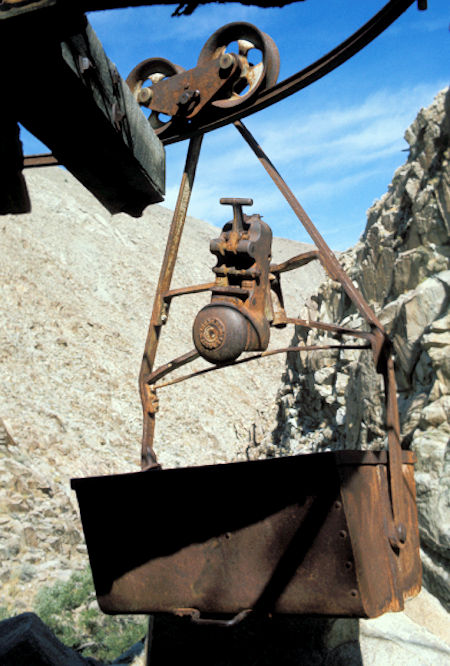
Ore bucket on lower tram terminal rail in 1975
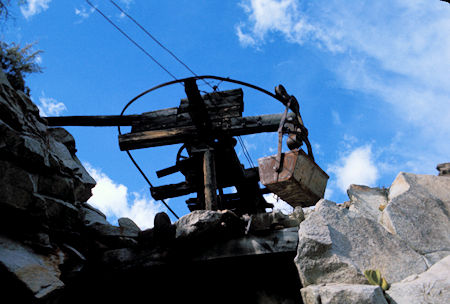
Ore bucket on rail at lower tram terminal
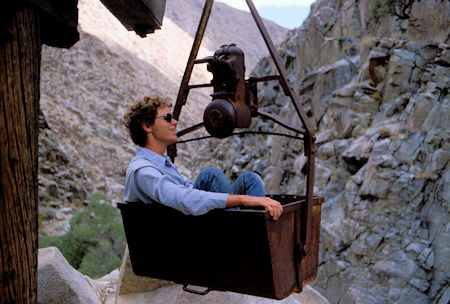
Jimmy White in ore bucket on lower tram terminal rail in 1981
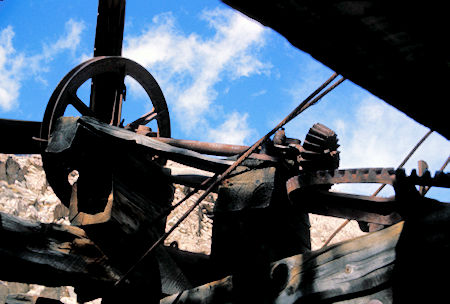
Drive gears at the lower tram terminal
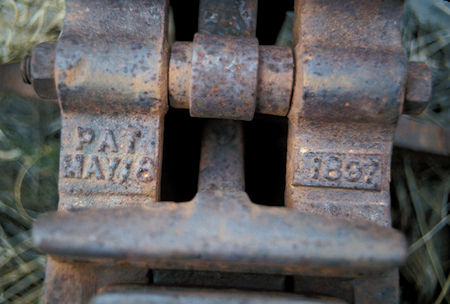
May 18, 1887 date on ore bucket hanger
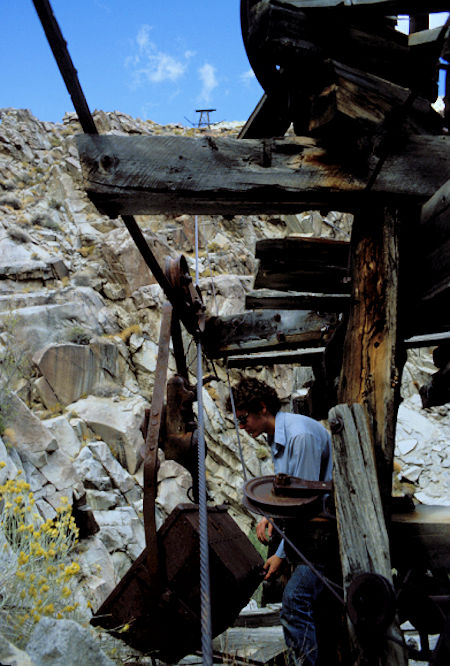
Looking up the tram cables past the ore bucket on the lower tram terminal rail
... Jimmy White
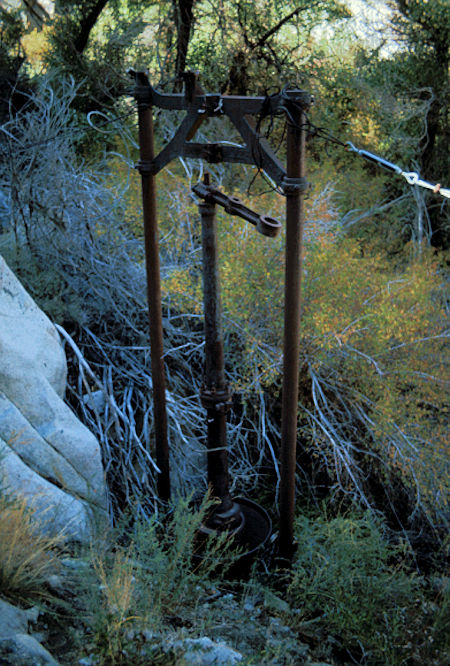
Appears to be support for collapsed conveyor belt system
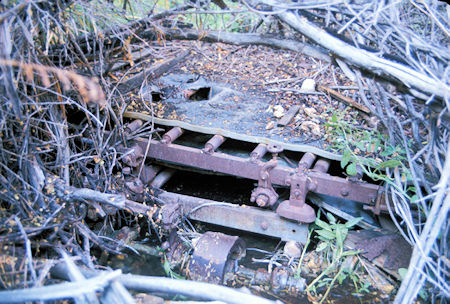
Conveyor belt system has collapsed into the creek
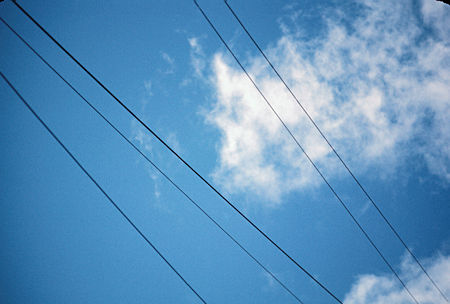
Most of the tram cables are still in the air
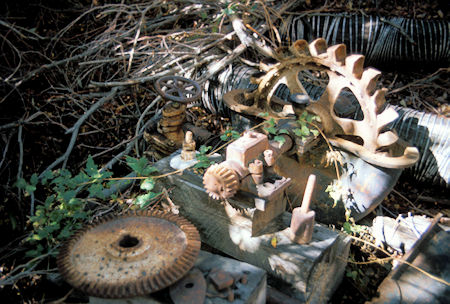
Pelton wheel in 1975 that used water to turn machinery
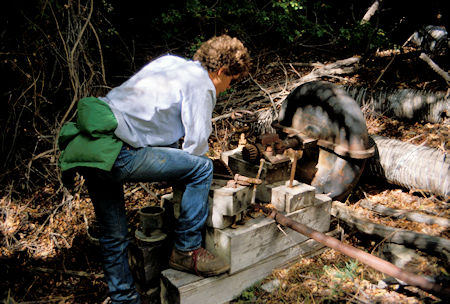
Jimmy White examines Pelton Wheel in 1981 that used water to power machinery.
Someone has put the top back on. Note old wooden pipe
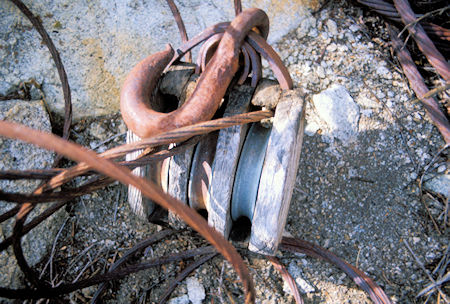
Old pulley
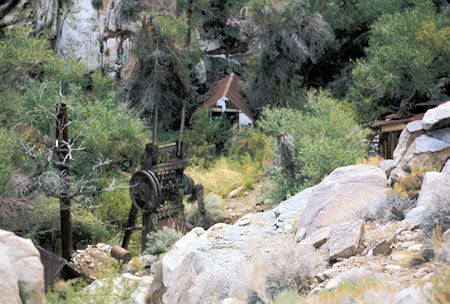
Looking down on the five stamp mill and nearby canvas sided cabin.
Note smoke stack for boiler on the left
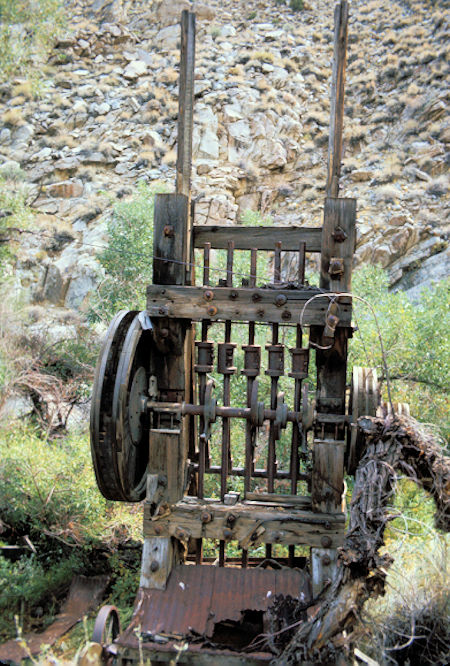
Five stamp mill
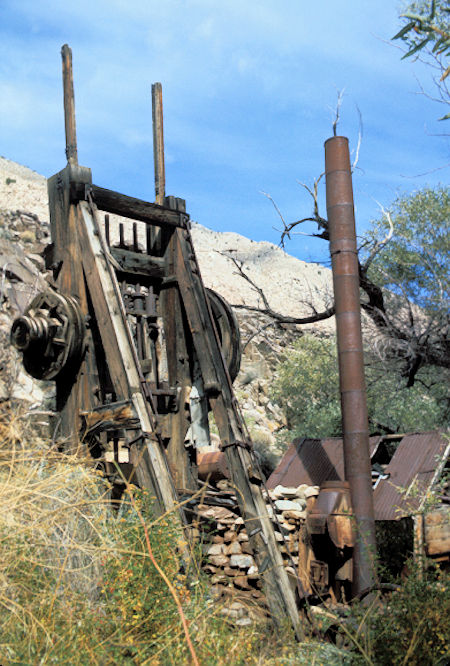
Five stamp mill. Note boiler just to the right and the smoke stack for the boiler
which is held upright by guy wires even though it has fallen off the top of the firebox
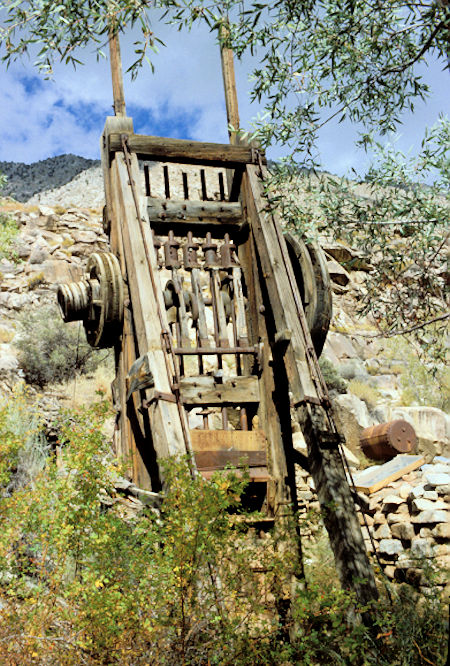
Five Stamp Mill in 1981
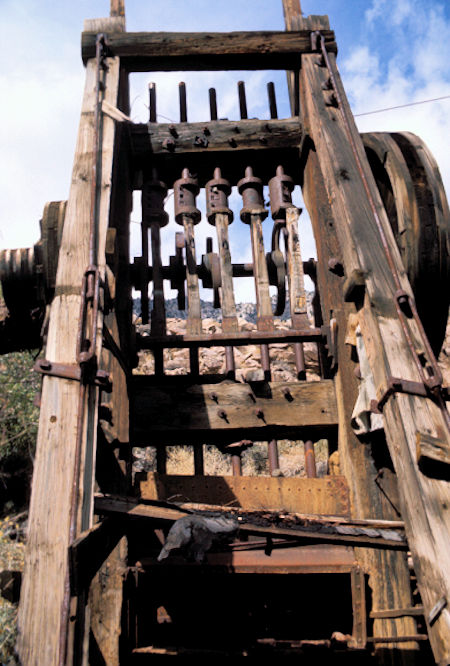
Five stamp mill
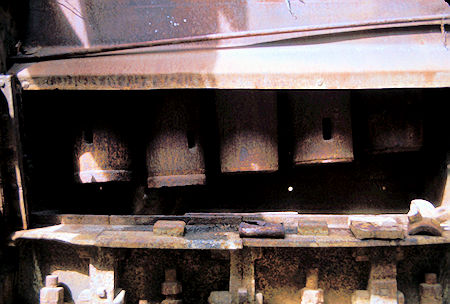
Stamps that crushed the ore in the Five Stamp Mill
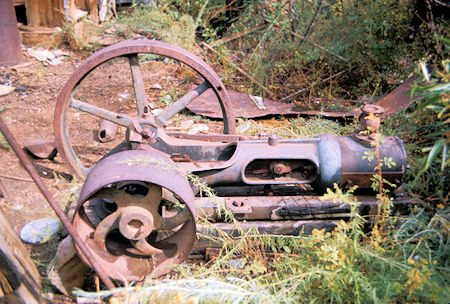
Steam engine that drove the belt which powered the stamp mill
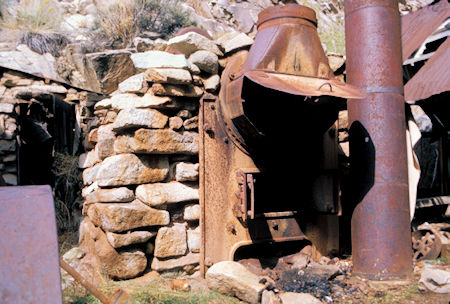
Boiler firebox ... smoke stack has fallen off top of firebox but is held upright by guy wires
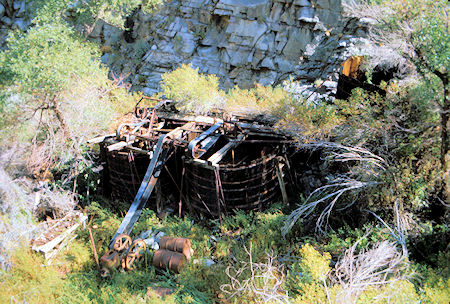
Chemical processing plant ... maybe Cyanide
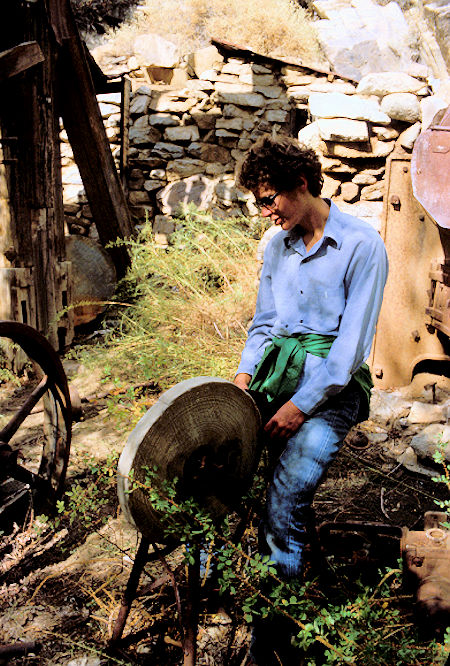
Jimmy White checks out grinding wheel near stamp mill boiler in 1981
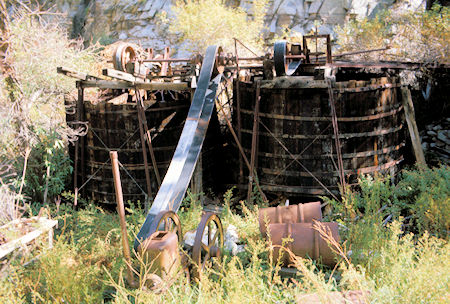
Chemical processing plant ... maybe Cyanide
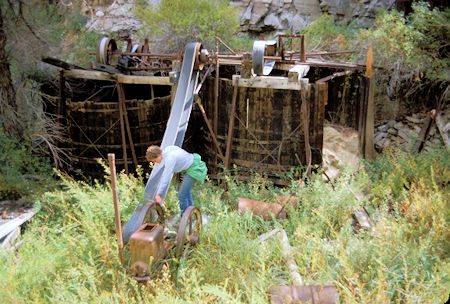
Jimmy White examines chemical processing plant in 1981 ... maybe Cyanide
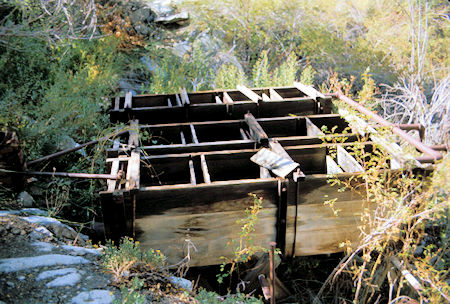
Appears to be an ore separation frame
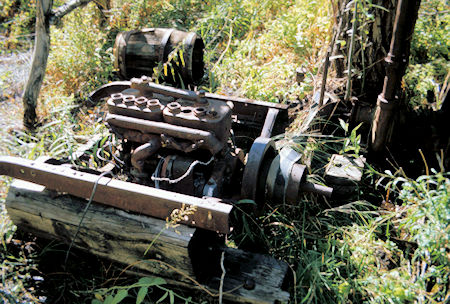
Gasoline engine to power recirculation pump
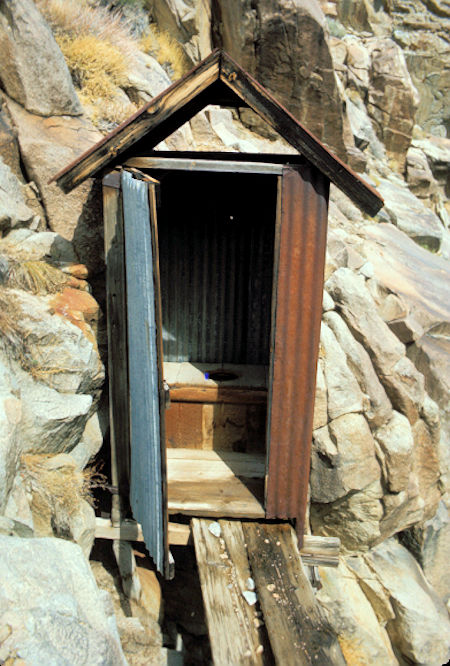
Outhouse perched on side of cliff
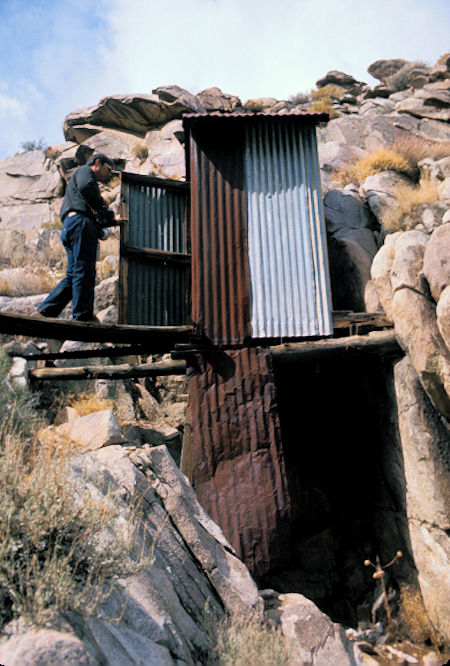
Stan Haye checks outhouse perched on side of cliff
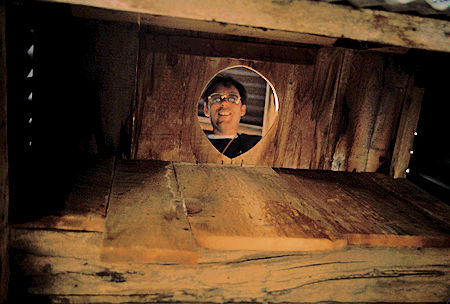
Turd's eye view under outhouse
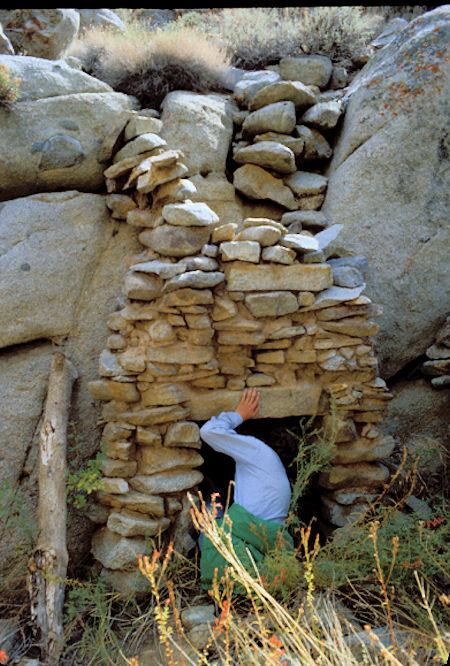
Jimmy White examines rock work in 1981 ... may have been a fireplace or a storage area